Influence of Weather-Driven Processes on the Performance of UK Transport Infrastructure with Reference to Historic Geostructures
Abstract
:1. Introduction
2. Transport Infrastructure Construction History in the UK
2.1. Pre-Regulation
2.1.1. Railway—19th and Early 20th Century
2.1.2. Highway—19th and Early 20th Century
2.2. Post-Regulation
- 1951—Specification for Road and Bridge Works introduced ‘end-product’ criteria
- 1959—BS 6031 set out the code of practice for earthworks
- 1969 and 1976—Specification for Highway Works (SWH) introduced ‘method compaction’
- 1975—BS 1377 was updated with new testing procedures
- 1986—SHW included various updates to end-product criteria, method compaction, and fill suitability selection
- 2004—Eurocode 7 (EC7) European standards introduced into UK practice
- 2009—BS 6031 Code of Practice for Earthworks fully updated to reflect modern methods and EC7
- 2021—Underlying principles of the current SHW remain unchanged after the various updates in the 1970s and 1980s
2.2.1. Railway—Mid 20th and 21st Century
- disturbance of substructure and tracks,
- fallen branches,
- fallen trees,
- loss of traction owing to leaf fall,
- settlement or heave of over-consolidated clay soils (plastic clay fills),
- penetration or blocking of drains and ditches.
2.2.2. Highway—Mid 20th and 21st Century
2.3. Current Regulations
3. Geostructures Vulnerabilities
- plasticity,
- susceptibility to erosion and degradation,
- vegetation type and distribution,
- permeability and permeability contrasts,
- underdrainage and ‘hidden defects’ (relict failures, or pockets of different permeability).
4. Failure Mechanisms
5. Climate Change
- the results are dependent on assumptions made in the RCPs—future pathways may be different or more complex than expected,
- probabilistic projections depend upon several statistical dataset assumptions which are made using expert judgement and may change,
- global climate models have greater confidence for long-term climate averages than extreme events,
- climate projections will evolve with time as modelling methods are improved and computer power is increased.
6. Impact of Climate Change on Transport Infrastructure Assets
- the impact of climate change on the European subcontinent will vary with location; the northwest being affected most greatly by increased winter precipitation, soil water content and therefore rainfall induced slope instability, while the Mediterranean region is expected to experience larger temperature rises compared to the European average and reduced annual precipitation,
- increased surface runoff may result in external erosion owing to the loss of vegetation during drought periods (this requires consideration for future drainage design),
- desiccation will increase infiltration resulting in increased pore pressure response and internal erosion,
- the impact of shrink swell in plastic soils will increase due to the cyclic nature of wetter winters and drier summers,
- the frequency of these shrink swell cycles may also increase due to summer storms (which will intensify progressive failure mechanisms),
- saturation, resulting from increased average rainfall and extreme events, in combination with the above factors will increase the pore water response in winter months.

7. Soil–Atmosphere Interaction Research Methods
8. Impacts of Hydraulic History on Compacted Soils
9. Desiccation
- Internal factors—mineral composition, fines content, water retention characteristics, and tensile strength
- External factors—temperature, relative humidity, and wetting and drying cycles
- the poorly compacted panel had the greatest number of cracks with 11 of the 19 cracks present on the slope,
- a linear cracking style was observed which contrasts with polygonal style generally seen in the laboratory (thought to be a result of root density),
- wind data showed a sheltering of the northern slope while there was increased solar radiation exposure on the southern face, which resulted in increased vegetation diversity (hypothesized to result in preferential crack formation on the southern slope),
- the upper section of the southern slope was subject to higher negative pore pressures during drying periods which was attributed to drainage under gravity, increased wind exposure, and surface runoff.
10. Conclusions
Author Contributions
Funding
Acknowledgments
Conflicts of Interest
References
- Skempton, A.W. Embankments and Cuttings on the Early Railways. Constr. Hist. 1996, 11, 33–49. [Google Scholar]
- Loveridge, F.; Spink, T.W.; O’Brien, A.S.; Briggs, K.M.; Butcher, D. The impact of climate and climate change on infrastructure slopes, with particular reference to southern England. Q. J. Eng. Geol. Hydrogeol. 2010, 43, 461–473. [Google Scholar] [CrossRef]
- O’Brien, A.S.; Ellis, E.A.; Russell, D. Old Railway Embankment Clay Fill—Laboratory Experiments, Numerical Modelling and Field Behaviour. In Advances in Geotechnical Engineering: The Skempton Conference; Thomas Telford Publishing: London, UK, 2004; pp. 911–921. [Google Scholar]
- Mcginnity, B.T.; Russell, D. Investigation of London Underground earth structures. In Advances in Site Investigation Practice; Thomas Telford Publishing: London, UK, 1995; pp. 230–242. [Google Scholar]
- Briggs, K.M.; Loveridge, F.A.; Glendinning, S. Failures in transport infrastructure embankments. Eng. Geol. 2017, 219, 107–117. [Google Scholar] [CrossRef] [Green Version]
- Noakes, P.; Mason-Jarvis, L.F.; Taylor, G.R.; Evans, E. Geospatial assessment methods for geotechnical asset management of legacy railway embankments. Q. J. Eng. Geol. Hydrogeol. 2020, 53, 339–348. [Google Scholar] [CrossRef]
- Tang, A.M.; Hughes, P.N.; Dijkstra, T.A.; Askarinejad, A.; Brenčič, M.; Cui, Y.J.; Diez, J.J.; Firgi, T.; Gajewska, B.; Gentile, F.; et al. Atmosphere–vegetation–soil interactions in a climate change context; impact of changing conditions on engineered transport infrastructure slopes in Europe. Q. J. Eng. Geol. Hydrogeol. 2018, 51, 156–168. [Google Scholar] [CrossRef]
- Lowe, J.; Bernie, D.; Bett, P.; Bricheno, L.; Brown, S.; Calvert, D.; Clark, R.; Eagle, K.; Edwards, T.; Fosser, G.; et al. UKCP 18 Science Overview Report November 2018 (Updated March 2019). Available online: https://www.metoffice.gov.uk/pub/data/weather/uk/ukcp18/science-reports/UKCP18-Overview-report.pdf (accessed on 11 May 2021).
- Network Rail. A Review of Earthworks Management. Available online: https://www.networkrail.co.uk/wp-content/uploads/2021/03/Network-Rail-Earthworks-Review-Final-Report.pdf (accessed on 20 August 2021).
- RAIB. Rail Accident Investigation Interim Report Derailment of a Passenger Train at Carmont, Aberdeenshire 12 August 2020. Available online: https://assets.publishing.service.gov.uk/government/uploads/system/uploads/attachment_data/file/978828/IR012021_210419_Carmont.pdf (accessed on 19 August 2021).
- BBC News. Fatal train derailment ‘Like Hornby Set Thrown in Air’. Available online: https://www.bbc.co.uk/news/uk-scotland-north-east-orkney-shetland-54191006 (accessed on 15 September 2020).
- BBC News. Stonehaven Train Derailment: Crash Investigators Confirm Train Struck Landslip. Available online: https://www.bbc.co.uk/news/uk-scotland-north-east-orkney-shetland-53778891 (accessed on 15 September 2020).
- Nowak, P.; Gilbert, P. Earthworks: An historical perspective. In Earthworks: A guide; Thomas Telford Ltd.: London, UK, 2015; pp. 1–14. [Google Scholar]
- Nowak, P. Chapter 69 Earthworks design principles. In ICE Manual of Geotechnical Engineering: Volume II; Thomas Telford Ltd.: London, UK, 2012; pp. 1043–1046. [Google Scholar]
- Network Rail. Earthworks Technical Strategy. 2018. Available online: https://www.networkrail.co.uk/wp-content/uploads/2018/07/Earthworks-Technical-Strategy.pdf (accessed on 21 October 2020).
- Azizi, A.; Musso, G.; Jommi, C.; Cosentini, R. Evolving fabric and its impact on the shearing behaviour of a compacted clayey silt exposed to drying-wetting cycles. In Proceedings of the 7th International Conference on Unsaturated Soils (UNSAT2018), Hong Kong, China, 3–5 August 2018. [Google Scholar]
- Azizi, A.; Musso, G.; Jommi, C. Effects of repeated hydraulic loads on microstructure and hydraulic behaviour of a compacted clayey silt. Can. Geotech. J. 2019, 57, 100–114. [Google Scholar] [CrossRef]
- Cheng, Q.; Tang, C.; Zeng, H.; Zhu, C.; An, N.; Shi, B. Effects of microstructure on desiccation cracking of a compacted soil. Eng. Geol. 2020, 265, 105–418. [Google Scholar] [CrossRef]
- Stirling, R.A.; Toll, D.G.; Glendinning, S.; Helm, P.R.; Yildiz, A.; Hughes, P.N.; Asquith, J.D. Weather-driven deterioration processes affecting the performance of embankment slopes. Géotechnique 2020, 71, 957–969. [Google Scholar] [CrossRef]
- Wikimedia Commons. Wolverton Viaduct—Public Domain Image. Available online: https://commons.wikimedia.org/wiki/File:Wolverton_viaduct.jpg (accessed on 10 September 2021).
- Gellatley, M.J.; McGinnity, B.T.; Barker, D.H.; Rankin, W.J. Interaction of Vegetation with LUL Surface Railway Systems. In Vegetation and Slopes: Stabilisation, Protection and Ecology: Proceedings of the International Conference Held at the University Museum, Oxford, 29–30 September 1994; Thomas Telford Ltd.: London, UK, 1995; pp. 60–71. [Google Scholar]
- Proctor, R.R. Fundamental principles of soil compaction. Eng. News Rec. 1933, 111, 286–289. [Google Scholar]
- Atterberg, A. Die Plastizität der Tone (The plasticity of clays). Int. Mitt. Bodenkd. 1911, 1, 4–37. [Google Scholar]
- Terzaghi, K. Principles of final soil classification. Public Roads 1926, 8, 41–53. [Google Scholar]
- Casagrande, A. Research on the Atterberg Limits of Soil. Public Roads 1932, 13, 121–136. [Google Scholar]
- Kodikara, J.; Islam, T.; Sounthararaja, A. Review of soil compaction: History and recent developments. Transp. Geotech. 2018, 17, 24–34. [Google Scholar] [CrossRef]
- Perry, J.; Pedly, M.; Reid, M. Infrastructure Embankments C550; CIRIA: London, UK, 2003. [Google Scholar]
- Porter, O.J. The preparation of subgrades. Highway Res. Board Proc. 1939, 18, 324–331. [Google Scholar]
- Alawia, M.H.; Rajab, M.I. Prediction of California bearing ratio of subbase layer using multiple linear regression models. Road Mater. Pavement Des. 2013, 14, 211–219. [Google Scholar] [CrossRef]
- Nowak, P.; Gilbert, P. Earthworks: A Guide, 2nd ed.; ICE: London, UK, 2015; Available online: https://www.icevirtuallibrary.com/isbn/9780727741851 (accessed on 6 February 2020).
- Sargent, C. Britain’s Railway Vegetation; Institute of Terrestrial Ecology: Cambridge, UK, 1984. [Google Scholar]
- Highways England. Design Manual for Roads and Bridges (DMRB), Volume 10, Section 3, Part 2: Landscape Management Handbook; The Stationary Office: London, UK, 2004. [Google Scholar]
- Glendinning, S.; Loveridge, F.; Starr-Keddle, R.E.; Bransby, M.F.; Hughes, P.N. Role of vegetation in sustainability of infrastructure slopes. Proc. Inst. Civ. Eng.-Eng. Sustain. 2009, 162, 101–110. [Google Scholar] [CrossRef]
- Greenwood, J.R.; Norris, J.E.; Wint, J. Assessing the contribution of vegetation to slope stability. Proc. Inst. Civ. Eng.-Geotech. Eng. 2004, 157, 199–207. [Google Scholar] [CrossRef]
- Yeadon, H.L. Preston By-pass: The first motorway in the UK. Proc. Inst. Civ. Eng.-Eng. Hist. Heritage 2010, 163, 117–128. [Google Scholar] [CrossRef]
- Drake, J. Buliding The Motorway. Gaurdian, 5 December 1958; p. 16. Available online: https://www.newspapers.com/clip/90396771/preston-by-pass-construction/(accessed on 8 July 2022).
- Macmillan, H. Preston By-Pass Official Opening Booklet. Ministry of Transport and Civil Aviation Agent Authority. 1958. Available online: https://www.roads.org.uk/sites/default/files/articles/opening-booklets/prestonbypass.pdf (accessed on 8 July 2022).
- Sarsby, R.W. Compaction and earthworks. In Environmental Geotechnics; Thomas Telford Publishing: London, UK, 2013; pp. 59–76. [Google Scholar]
- Highways England. Climate Change Adaptation Strategy and Framework; England, H., Ed.; Home Office: London, UK, 2009. [Google Scholar]
- Network Rail. Claimte Change Adaptation Report; Network Rail Limited: London, UK, 2015. [Google Scholar]
- Varley, J. The Network Rail Vegetation Management Review; Home Office: London, UK, 2018. [Google Scholar]
- Network Rail. Vegetation Management. Available online: https://www.networkrail.co.uk/communities/environment/vegetation-management/ (accessed on 12 November 2020).
- O’Brien, A.S. The assessment of old railway embankments: Time for a change? Géotechnique 2013, 19–32. [Google Scholar] [CrossRef]
- Heitor, A.; Grady, M.; Russel, R.; Vongsvivut, J. Bio-mediated soil stabilisation using biopolymers for enhancing performance of transport infrastructure. In Eleventh International Conference on the Bearing Capacity of Roads, Railways and Airfields; CRC: Boca Raton, FL, USA, 2022; pp. 159–167. [Google Scholar]
- Briggs, K.M.; Smethurst, J.; Powrie, W.; O’Brien, A.S. Wet winter pore pressures in railway embankments. Proc. Inst. Civ. Eng.-Geotech. Eng. 2013, 166, 451–465. [Google Scholar] [CrossRef] [Green Version]
- Hughes, P.N.; Glendinning, S.; Mendes, J.; Parkin, G.; Toll, D.G.; Gallipoli, D.; Miller, P.E. Full-scale testing to assess climate effects on embankments. Proc. Inst. Civ. Eng.-Eng. Sustain. 2009, 162, 67–79. [Google Scholar] [CrossRef]
- Toll, D.; Lourenço, S.; Mendes, J.; Gallipoli, D.; Evans, F.; Augarde, C.; Cui, Y.; Tang, A.-M.; Rojas Vidovic, J.; Pagano, L.; et al. Soil suction monitoring for landslides and slopes. Q. J. Eng. Geol. Hydrogeol. 2011, 44, 23–33. [Google Scholar] [CrossRef]
- Ridley, A.; McGinnity, B.; Vaughan, P. Role of pore water pressures in embankment stability. Proc. Inst. Civ. Eng.-Geotech. Eng. 2004, 157, 193–198. [Google Scholar] [CrossRef]
- Kovacevic, N.; Potts, D.; Vaughan, P.R. Progressive failure in clay embankments due to seasonal climate changes. Proc. Int. Conf. Soil. Mech. Geotech. Eng. 2001, 3, 2127–2130. [Google Scholar]
- Nyambayo, V.P.; Potts, D.M.; Addenbrooke, T.I. The Influence Of Permeability On The Stability Of Embankments Experiencing Seasonal Cyclic Pore Water Pressure Changes. In Advances in Geotechnical Engineering: The Skempton Conference; Thomas Telford Ltd.: London, UK, 2004; pp. 898–910. [Google Scholar]
- Met Office. UKCP18 Guidance: Representative Concentration Pathways; Department for Environment Food & Rural Affairs: London, UK, 2018.
- van Vuuren, D.P.; Edmonds, J.; Kainuma, M.; Riahi, K.; Thomson, A.; Hibbard, K.; Hurtt, G.C.; Kram, T.; Krey, V.; Lamarque, J.-F.; et al. The representative concentration pathways: An overview. Clim. Change 2011, 109, 5. [Google Scholar] [CrossRef]
- IPCC Data Distribution Centre. Definition of Terms Used within the DDC Pages. 2019. Available online: https://www.ipcc-data.org/guidelines/pages/glossary/glossary_r.html (accessed on 20 October 2020).
- Hulme, M.; Dessai, S. Negotiating future climates for public policy: A critical assessment of the development of climate scenarios for the UK. Environ. Sci. Policy 2008, 11, 54–70. [Google Scholar] [CrossRef]
- Jenkins, G.; Murphy, J.; Sexton, D.; Lowe, J.; Jones, P.; Kilsby, C. UK Climate Projection Briefing Report. Available online: http://cedadocs.ceda.ac.uk/1321/ (accessed on 21 October 2021).
- Heitor, A.; Parkinson, J.; Kotzur, T. The Role of Soil Stabilisation in Mitigating the Impact of Climate Change in Transport Infrastructure with Reference to Wetting Processes. Appl. Sci. 2021, 11, 1080. [Google Scholar] [CrossRef]
- Clarke, D.; Smethurst, J.A. Effects of climate change on cycles of wetting and drying in engineered clay slopes in England. Q. J. Eng. Geol. Hydrogeol. 2010, 43, 473–486. [Google Scholar] [CrossRef]
- Kim, Y.; Kimball, J.S. Update to data originally published in: Kim, Y., J.S. Kimball, J. Glassy, and J. Du. 2017. An extended global Earth system data record on daily landscape freeze-thaw status determined from satellite passive microwave remote sensing. Earth Syst. Sci. Data 2020, 9, 133–147. [Google Scholar] [CrossRef] [Green Version]
- Caicedo, B. Physical modelling of freezing and thawing of unsaturated soils. Géotechnique 2017, 67, 106–126. [Google Scholar] [CrossRef]
- Ishikawa, T.; Tokoro, T.; Miura, S. Influence of freeze–thaw action on hydraulic behavior of unsaturated volcanic coarse-grained soils. Soils Found. 2016, 56, 790–804. [Google Scholar] [CrossRef]
- Zhu, F.; Heitor, A. Influence of Water Content on Track Degradation at Transition Zones. Transp. Infrastruct. Geotechnol. 2022, 9, 32–53. [Google Scholar] [CrossRef]
- Khalili, N.; Habte, M.A.; Zargarbashi, S. A fully coupled flow deformation model for cyclic analysis of unsaturated soils including hydraulic and mechanical hystereses. Comput. Geotech. 2008, 35, 872–889. [Google Scholar] [CrossRef]
- Gitirana, G., Jr. Weather Related Geo-Hazard Assessment Model for Railway Embankment Stability; University of Saskatchewan: Saskatoon, SK, Canada, 2005. [Google Scholar]
- Glendinning, S.; Hughes, P.; Helm, P.; Chambers, J.; Mendes, J.; Gunn, D.; Wilkinson, P.; Uhlemann, S. Construction, management and maintenance of embankments used for road and rail infrastructure: Implications of weather induced pore water pressures. Acta Geotech. 2014, 9, 799–816. [Google Scholar] [CrossRef]
- Toll, D.; Mendes, J.; Gallipoli, D.; Glendinning, S.; Hughes, P. Investigating the impacts of climate change on slopes: Field measurements. Geol. Soc. Lond. Eng. Geol. Spec. Publ. 2012, 26, 151–161. [Google Scholar] [CrossRef]
- Glendinning, S.; Helm, P.; Rouainia, M.; Stirling, R.; Asquith, J.; Hughes, P.; Toll, D.; Clarke, D.; Powrie, W.; Smethurst, H.; et al. Research-informed design, management and maintenance of infrastructure slopes: Development of a multi-scalar approach. IOP Conf. Ser. Earth Environ. Sci. 2015, 26, 207–215. [Google Scholar] [CrossRef]
- Mendes, J. Assessment of the Impact of Climate Change on an Instrumented Embankment: An Unsaturated Soil Mechanics Approach. Ph.D. Thesis, Durham University, Durham, UK, 2011. [Google Scholar]
- Take, W.A.; Bolton, M.D. Seasonal ratcheting and softening in clay slopes, leading to first-time failure. Géotechnique 2011, 61, 757–769. [Google Scholar] [CrossRef] [Green Version]
- Stirling, R.A.; Glendinning, S.; Davie, C.T. Modelling the deterioration of the near surface caused by drying induced cracking. Appl. Clay Sci. 2017, 146, 176–185. [Google Scholar] [CrossRef]
- Mendes, J.; Toll, D.G. Influence of Initial Water Content on the Mechanical Behavior of Unsaturated Sandy Clay Soil. Int. J. Geomech. 2016, 16, D4016005. [Google Scholar] [CrossRef] [Green Version]
- Briggs, K.M.; Dijkstra, T.A.; Glendinning, S. Evaluating the Deterioration of Geotechnical Infrastructure Assets Using Performance Curves. In Proceedings of the International Conference on Smart Infrastructure and Construction 2019 (ICSIC), Cambridge, UK, 8–10 July 2019; pp. 429–435. [Google Scholar]
- Pham, H.; Fredlund, D.; Barbour, S. A Study of hysteresis models for soil-water characteristic curves. Can. Geotech. J. 2005, 42, 1548–1568. [Google Scholar] [CrossRef]
- Gapak, Y.; Tadikonda, V.B. Hysteretic Water-Retention Behavior of Bentonites. J. Hazard. Toxic Radioact. Waste 2018, 22, 04018008. [Google Scholar] [CrossRef]
- Goh, S.G.; Rahardjo, H.; Leong, E.C. Shear Strength of Unsaturated Soils under Multiple Drying-Wetting Cycles. J. Geotech. Geoenvironmental Eng. 2014, 140, 6–13. [Google Scholar] [CrossRef]
- Heitor, A.; Indraratna, B.; Rujikiatkamjorn, C. The role of compaction energy on the small strain properties of a compacted silty sand subjected to drying–wetting cycles. Géotechnique 2015, 65, 717–727. [Google Scholar] [CrossRef] [Green Version]
- Ng, C.W.W.; Xu, J.; Yung, S. Effects of wetting-drying and stress ratio on anisotropic stiffness of an unsaturated soil at very small strains. Can. Geotech. J. 2009, 46, 1062–1076. [Google Scholar] [CrossRef]
- Ng, C.W.W.; Xu, J. Effects of current suction ratio and recent suction history on small-strain behaviour of an unsaturated soil. Can. Geotech. J. 2012, 49, 226–243. [Google Scholar] [CrossRef]
- Khosravi, A.; Shahbazan, P.; Pak, A. Impact of hydraulic hysteresis on the small strain shear modulus of unsaturated sand. Soils Found. 2018, 58, 344–354. [Google Scholar] [CrossRef]
- Khosravi, A.; McCartney, J.S. Impact of Hydraulic Hysteresis on the Small-Strain Shear Modulus of Low Plasticity Soils. J. Geotech. Geoenvironmental Eng. 2012, 138, 1326–1333. [Google Scholar] [CrossRef]
- Likos, W.J.; Lu, N. Hysteresis of Capillary Stress in Unsaturated Granular Soil. J. Eng. Mech. 2004, 130, 646–655. [Google Scholar] [CrossRef]
- Costa, S.; Kodikara, J.; Shannon, B. Salient factors controlling desiccation cracking of clay in laboratory experiments. Géotechnique 2013, 63, 18–29. [Google Scholar] [CrossRef]
- Tang, C.; Zhu, C.; Leng, T.; Shi, B.; Cheng, Q.; Zeng, H. Three-dimensional characterization of desiccation cracking behavior of compacted clayey soil using X-ray computed tomography. Eng. Geol. 2019, 255, 1–10. [Google Scholar] [CrossRef]
- Julina, M.; Thyagaraj, T. Quantification of desiccation cracks using X-ray tomography for tracing shrinkage path of compacted expansive soil. Acta Geotech. 2019, 14, 35–56. [Google Scholar] [CrossRef]
- Yu, Z.; Eminue, O.O.; Stirling, R.; Davie, C.; Glendinning, S. Desiccation cracking at field scale on a vegetated infrastructure embankment. Géotech. Lett. 2021, 11, 88–95. [Google Scholar] [CrossRef]
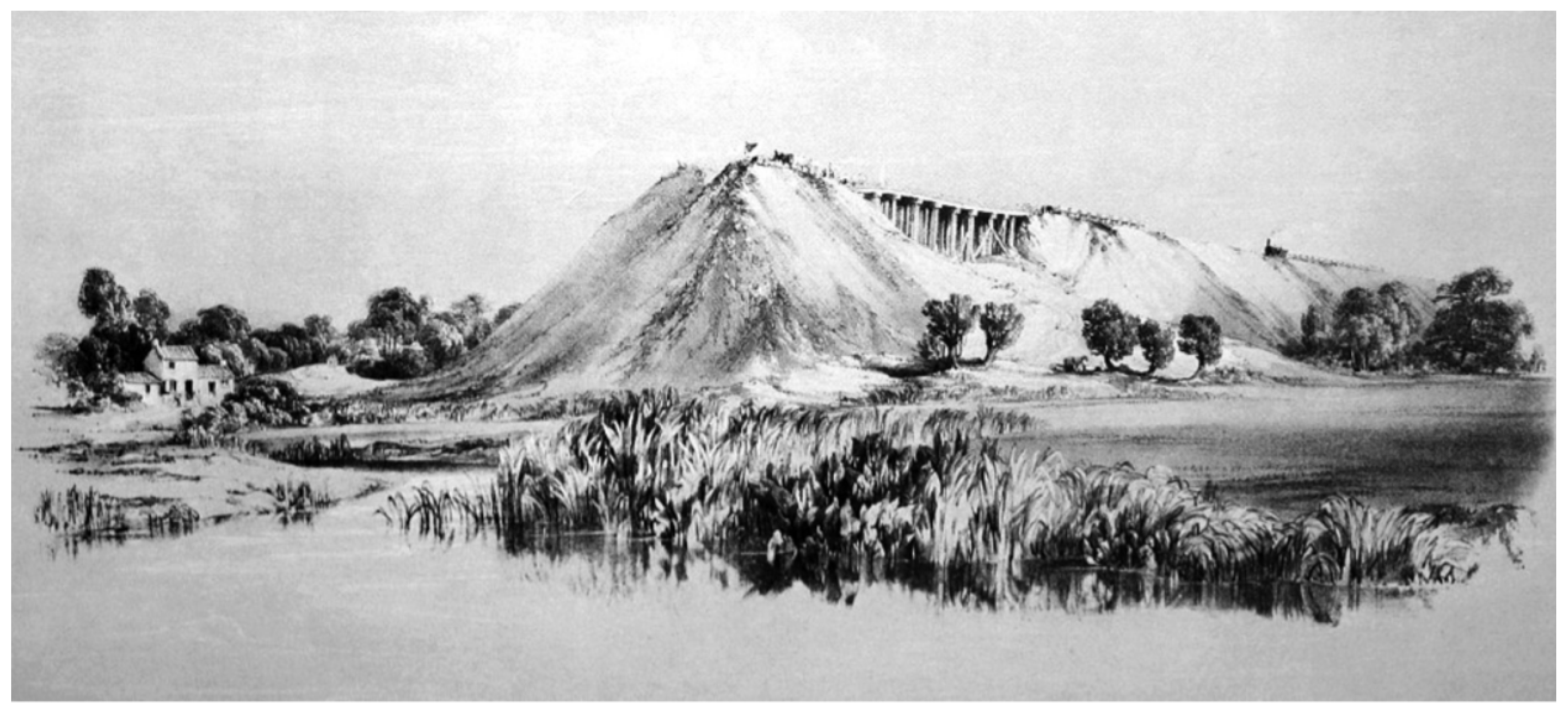
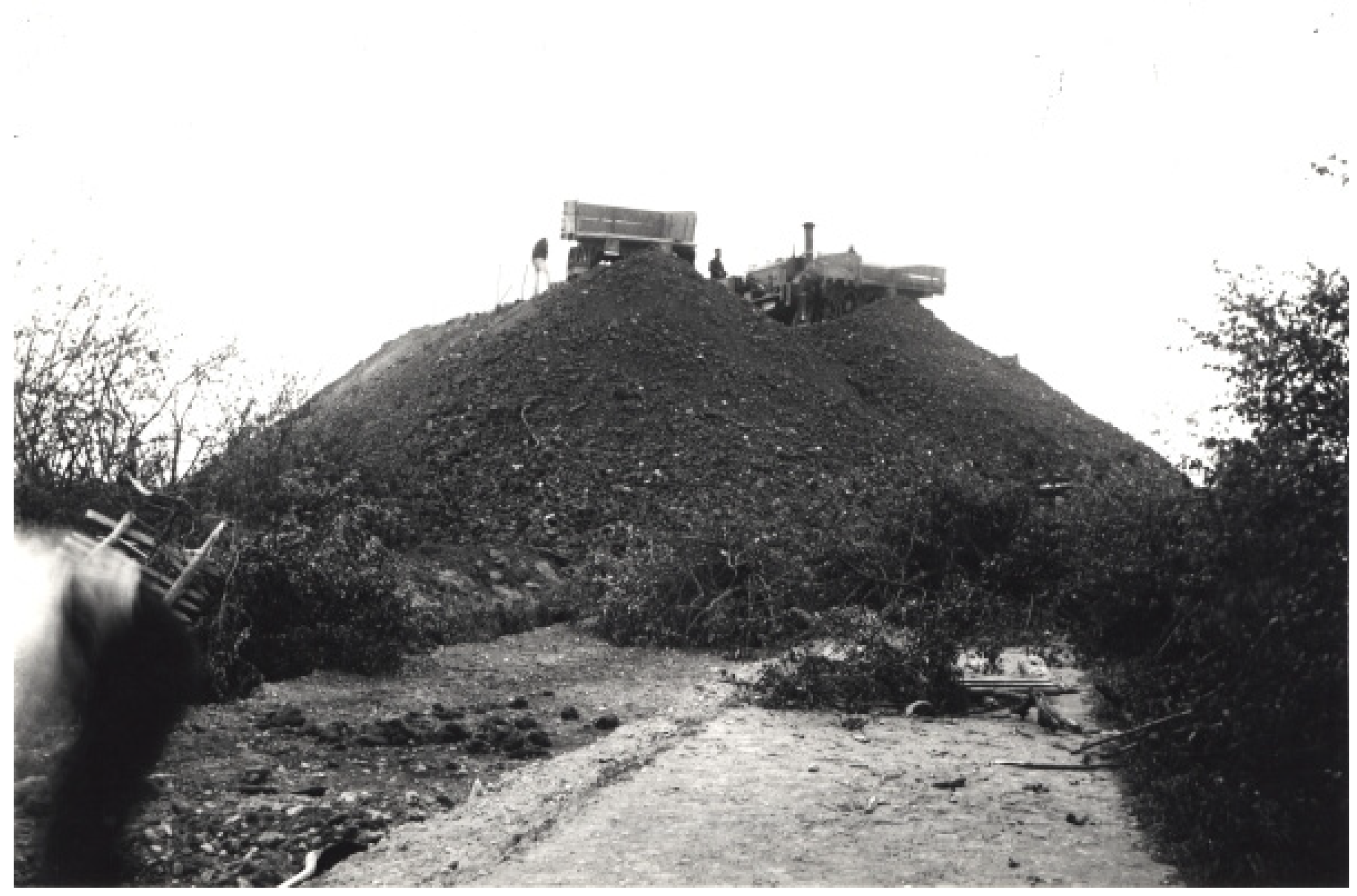

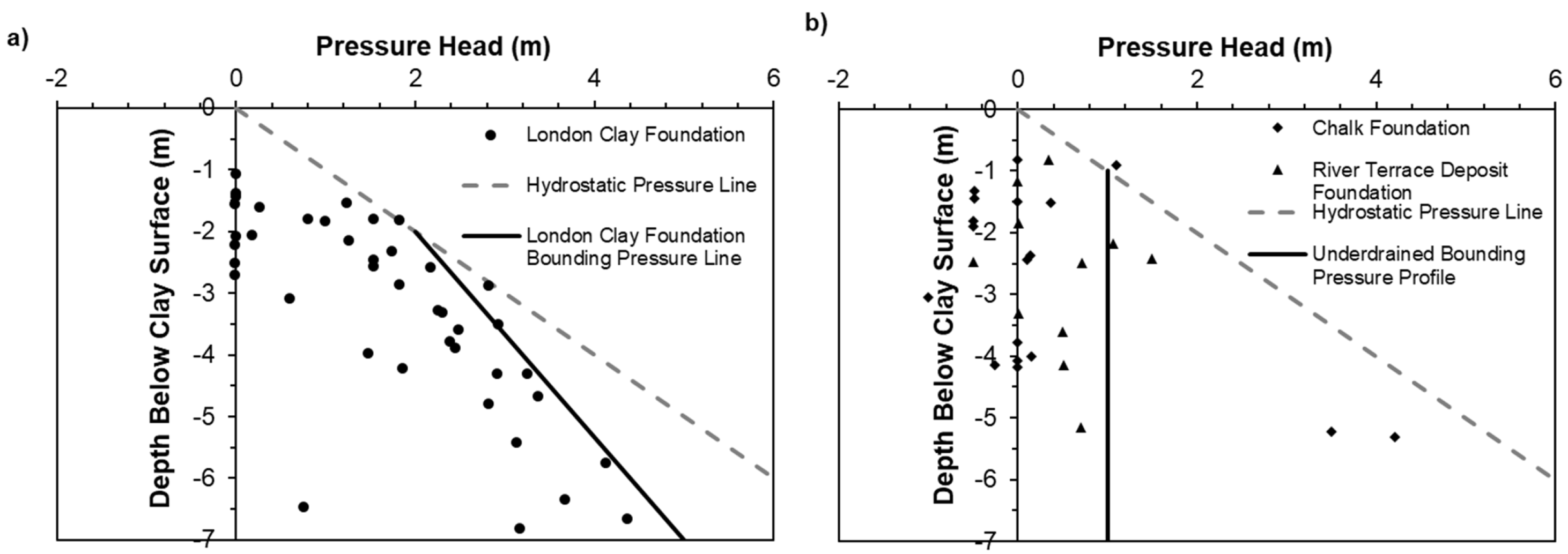


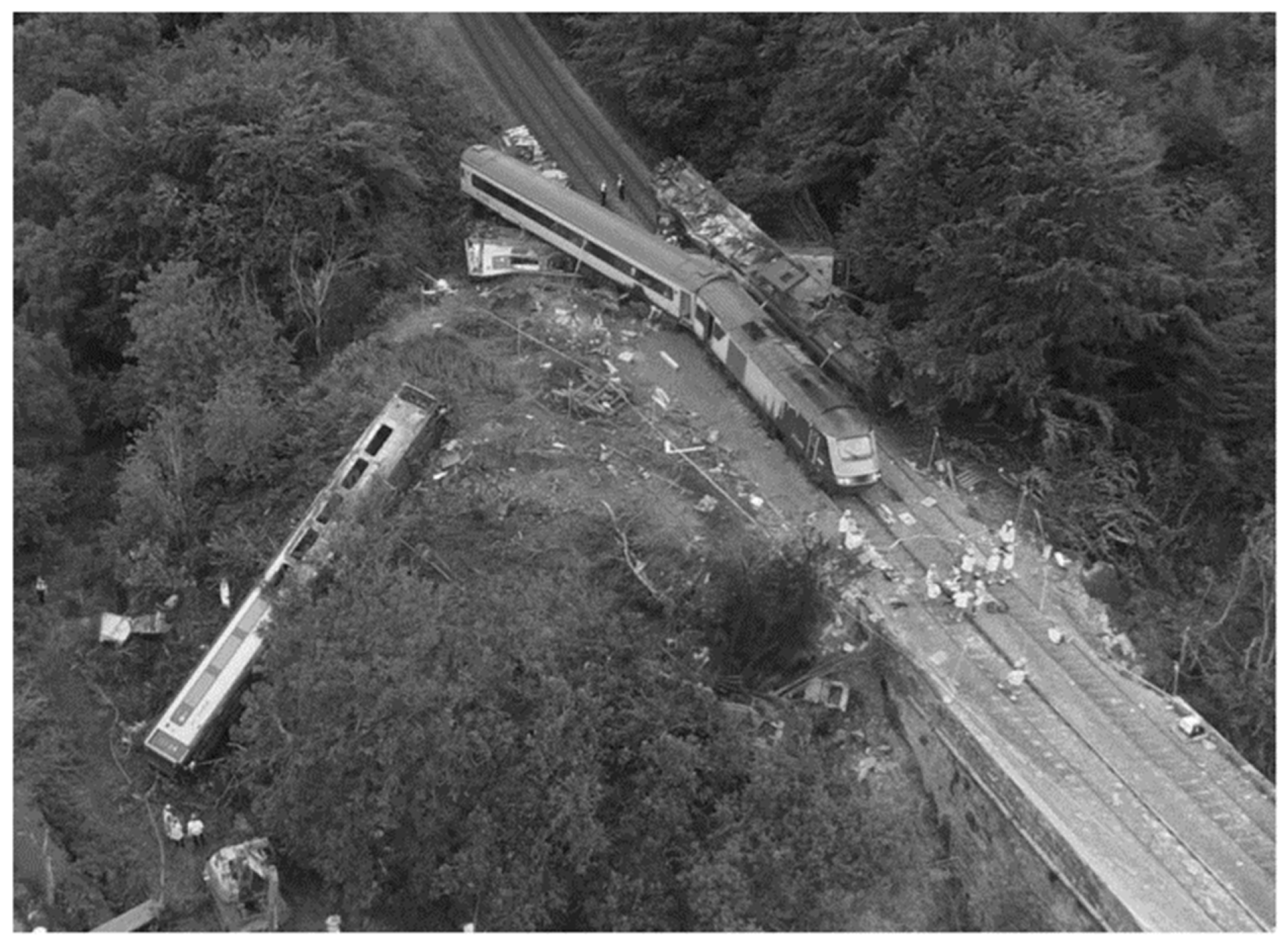
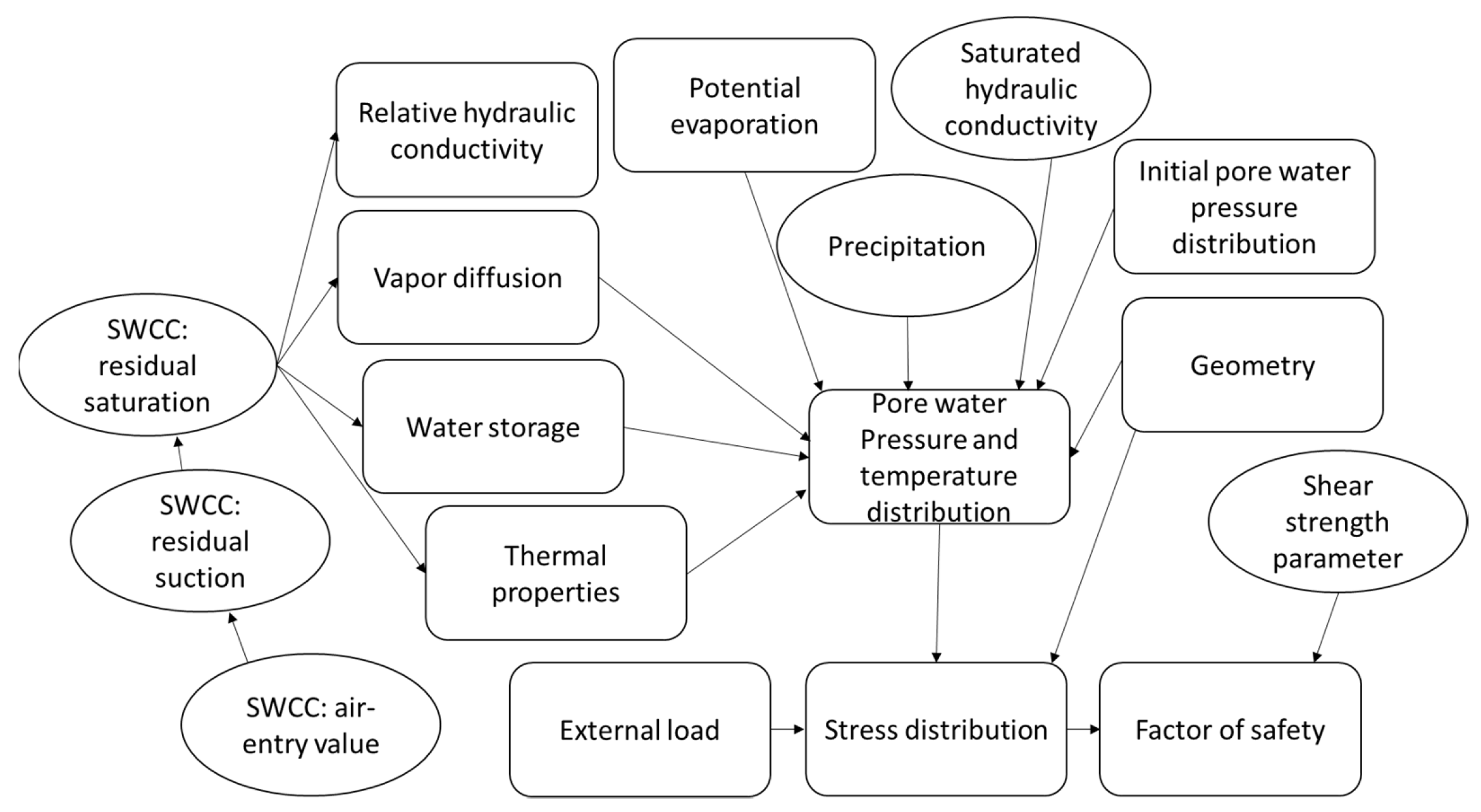

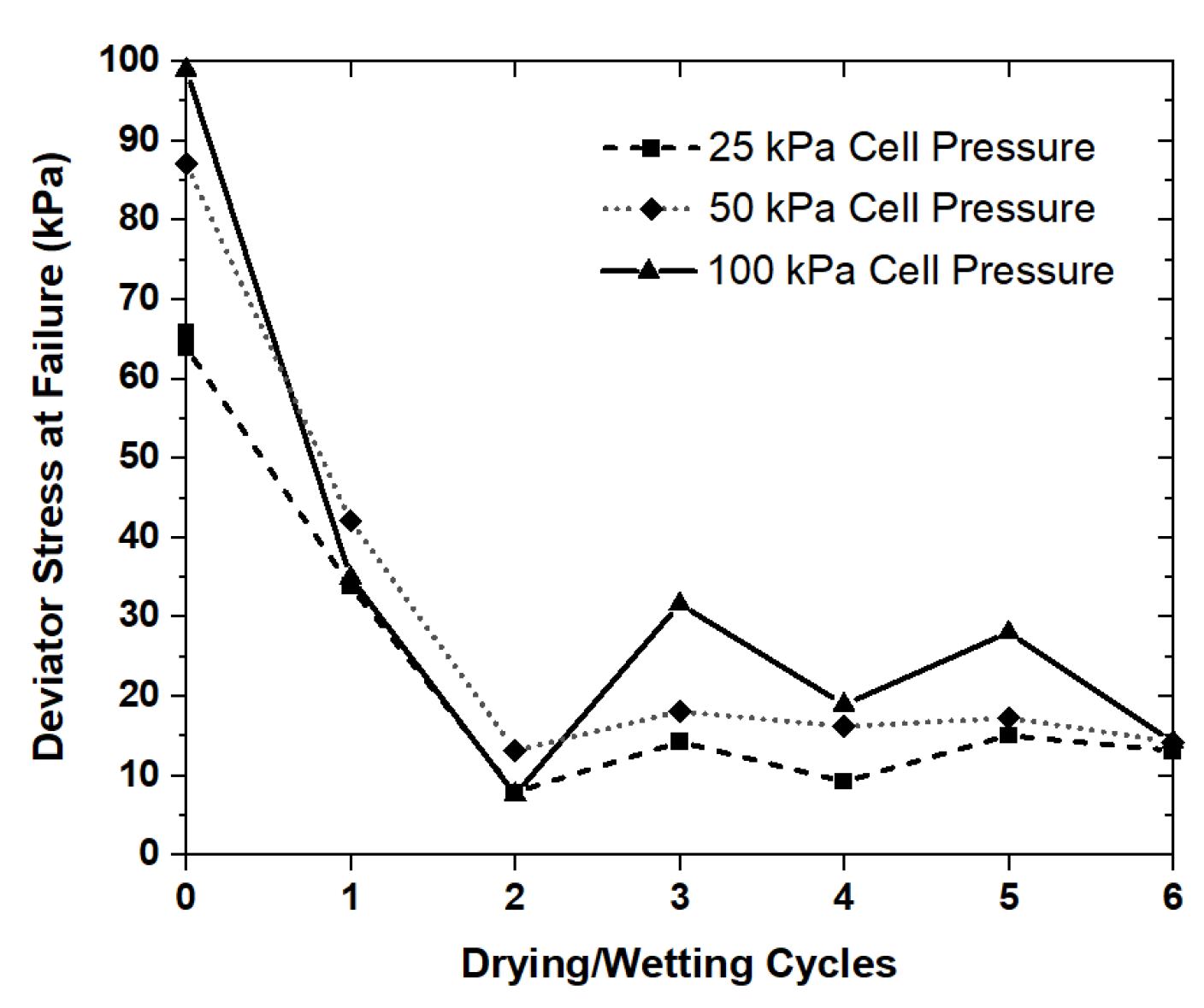
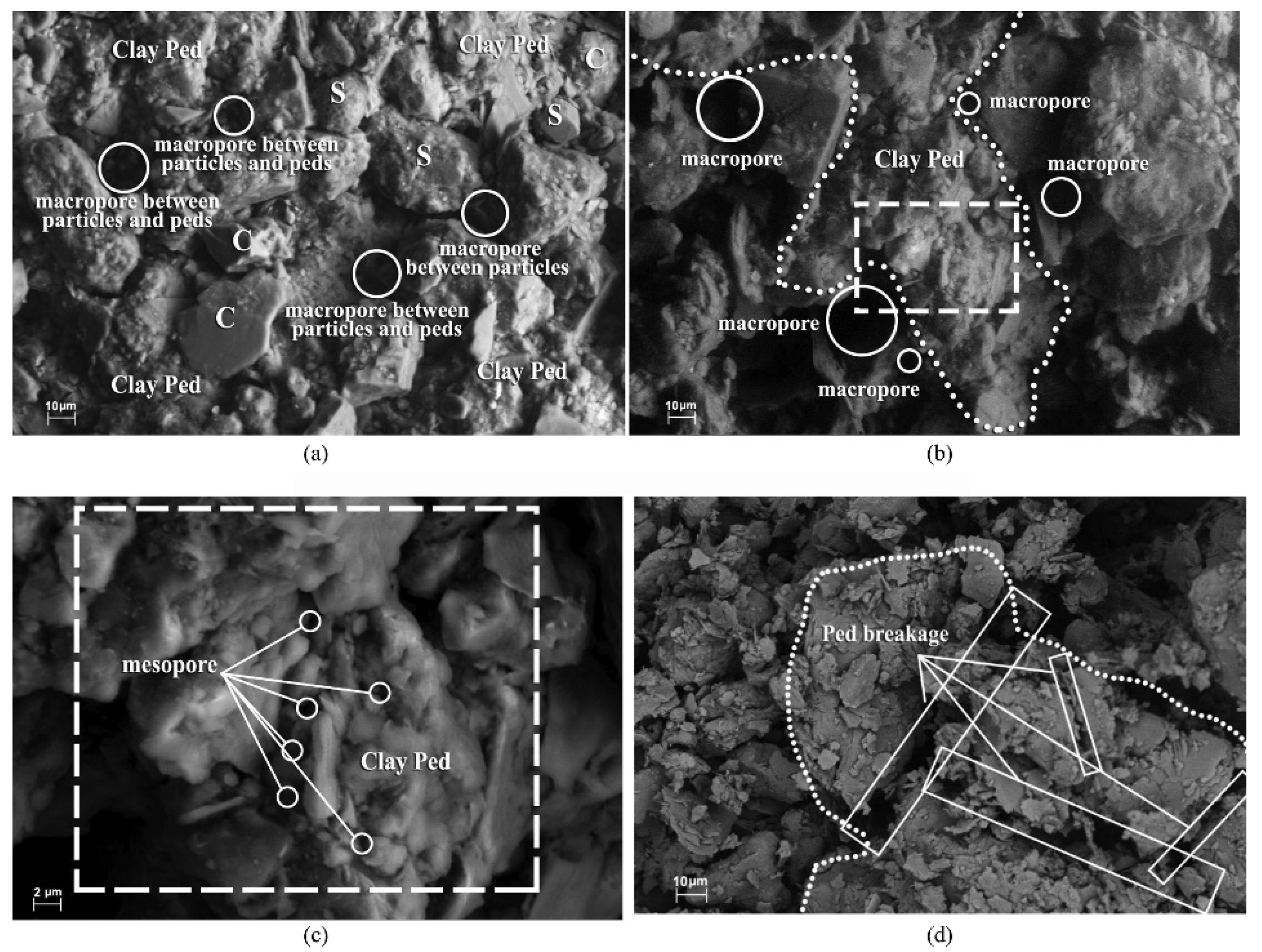

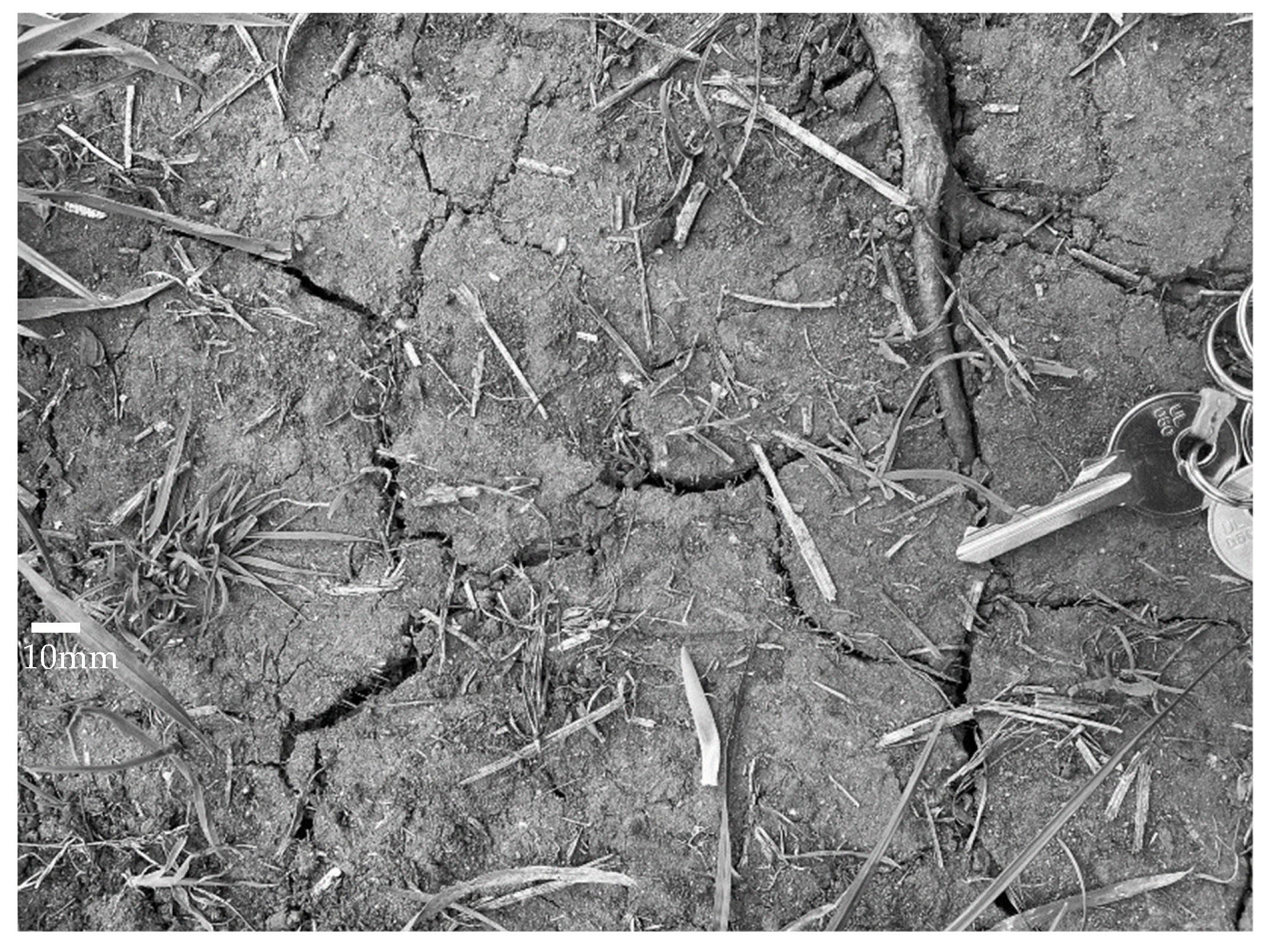
| Construction/Maintenance | Railway Only | Railway and Highway |
|---|---|---|
| Pre-Regulation—19th and Early 20th Century | Post-Regulation—Mid 20th and 21st Century | |
| Fill Material | Embankment fill sourced from adjacent cuttings with no quality control [1] | Due to the new specifications, material was still sourced from cuttings, but now exceptions were made for material deemed ‘unsuitable’, e.g., import of fill material during the construction of the Preston By-Pass [35] |
| Compaction | End-tipping was conducted with no compaction except at bridge abutments due to occurrence of differential settlement [14] | Earthworks were constructed to an ‘end-product’ criterion by setting a required percentage density or method compaction [13] |
| Slope Angle | Embankments were formed at the angle of repose, due to end-tipping, and trimmed to 1:2 (vertical: horizontal), in some cases up to 1:1.5 and 16 m in height [5] | Based off stability analysis and empirical observation of different geologies, e.g., infinite slope analysis, method of slices, and finite element calculated using Factor of Safety (FoS) for various construction stages |
| Foundations | No consideration was made and topsoil was often left in place [5] | Topsoil stripped and various ground improvement techniques used to provide adequate foundation conditions such as geotextiles, deep soil mixing, shallow stabilisation, vibro stone columns and drainage |
| Vegetation Management | Line-side gangs managed growth of vegetation to minimise the occurrence of line-side fires due to steam locomotion [21] | Mid-late 20th century, no management of vegetation was made on railway geostructures, however several vegetation standards now exist to manage risk and capitalise on its use for bioengineering [9] |
| Interventions | Ash packed under tracks to combat settlement and in situ burning of clay fills and the addition of ash took place to remediate landslips [9] | Asset management procedures including various monitoring techniques such as piezometers, inclinometers, remote sensing, tiltmeters, and measurement of track geometry |
| Failure Mechanisms | Causes of Climate Vulnerability |
|---|---|
| Deep-seated Rotational Failure |
|
| Shallow Translational Failure |
|
| Washout |
|
| Debris Flow |
|
| RCP (Wm2) | Temp Change by 2081–2100 (°C) | Assumptions |
|---|---|---|
| 2.6 | 1.6 | Population—approx. 8.75 billion by 2100 Global GDP increase of $375 trillion by 2100 Primary energy consumption of 750 EJ by 2100 Use of bioenergy and carbon capture and storage resulting in negative emissions by 2100 |
| 4.5 | 2.8 | Population—approx. 9 billion by 2100 Global GDP increase of $300 trillion by 2100 Primary energy consumption of 900 EJ by 2100 Same energy mix as RCP 2.6 but a less extreme move to low-carbon technologies and larger energy demand |
| 6.0 | 2.4 | Population—approx. 9.75 billion by 2100 Global GDP increase of $225 trillion by 2100 Primary energy consumption of 750 EJ by 2100 Same use of fossil fuels as RCP 8.5 but reduction in energy demand reduces release of emissions |
| 8.5 | 4.3 | Population—12 billion by 2100 Low per capita income growth Global GDP increase of $250 trillion by 2100 High primary energy consumption 1750 EJ by 2100 Increase in use of fossil fuels due to low technology development |
Publisher’s Note: MDPI stays neutral with regard to jurisdictional claims in published maps and institutional affiliations. |
© 2022 by the authors. Licensee MDPI, Basel, Switzerland. This article is an open access article distributed under the terms and conditions of the Creative Commons Attribution (CC BY) license (https://creativecommons.org/licenses/by/4.0/).
Share and Cite
Walker, C.; Heitor, A.; Clarke, B. Influence of Weather-Driven Processes on the Performance of UK Transport Infrastructure with Reference to Historic Geostructures. Appl. Sci. 2022, 12, 7461. https://doi.org/10.3390/app12157461
Walker C, Heitor A, Clarke B. Influence of Weather-Driven Processes on the Performance of UK Transport Infrastructure with Reference to Historic Geostructures. Applied Sciences. 2022; 12(15):7461. https://doi.org/10.3390/app12157461
Chicago/Turabian StyleWalker, Christopher, Ana Heitor, and Barry Clarke. 2022. "Influence of Weather-Driven Processes on the Performance of UK Transport Infrastructure with Reference to Historic Geostructures" Applied Sciences 12, no. 15: 7461. https://doi.org/10.3390/app12157461
APA StyleWalker, C., Heitor, A., & Clarke, B. (2022). Influence of Weather-Driven Processes on the Performance of UK Transport Infrastructure with Reference to Historic Geostructures. Applied Sciences, 12(15), 7461. https://doi.org/10.3390/app12157461






